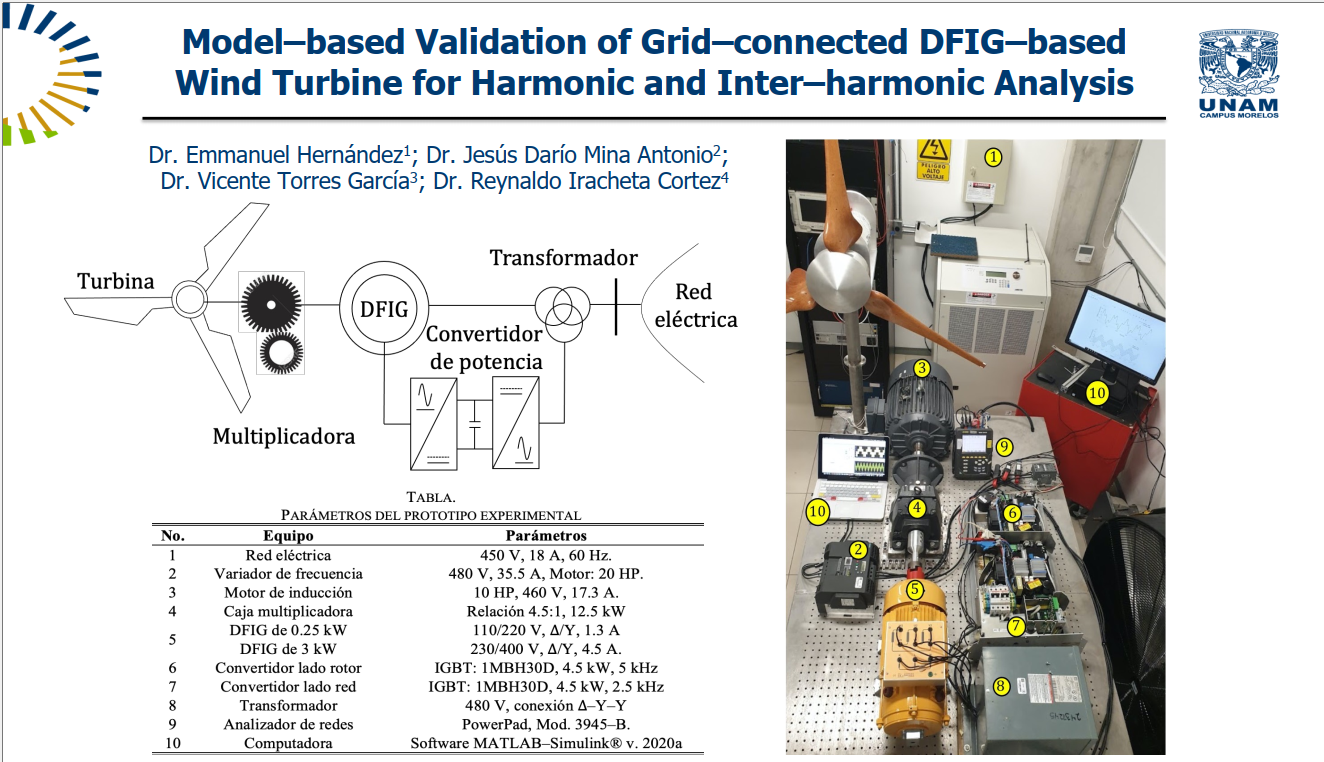Model–based Validation of Grid–connected DFIG–based Wind Turbine for Harmonic and Inter–harmonic Analysis
Keywords:
DFIG, Harmonic and inter-harmonic analysis, back-to-back power converterAbstract
Nowadays, the electricity generation study through wind resources is of great importance, because it is presented as a solution to reduce environmental pollution by replacing electrical systems based on conventional generation with clean energy. However, the increasing problems associated with power quality must be considered, mainly harmonic distortion, derived from the interconnection of wind turbines with the electrical grid, and even more because of their included power electronics converters. Therefore, in this article a DFIG–based wind turbine model connected to the electrical grid for harmonic and inter–harmonic analysis is developed. The proposed model is validated with a low–power experimental prototype (175 W and 3 kW). Both, simulation and experimental results agree with the analytical results
Downloads
References
. J. Murphy and F. Turnbull, Power Electronics Control of AC Motors. New York: Pergamon, 1988.
. N. Mohan, First Course on Power Electronics. Englewood Cliffs, NJ: MNPERE/Prentice-Hall, 2005
. M. Yin, Y. Xu, C. Shen, J. Liu, Z. Yang, and Y. Zou, “Turbine Stability– Constrained Available Wind Power of Variable Speed Wind Turbines for Active Power Control,” IEEE Trans. on Power Syst., vol. 32, no. 3, pp. 2487–2488, 2017.
. I. Erlich and F. Shewarega, "Modeling of Wind Turbines Equipped with Doubly-Fed Induction Machines for Power System Stability Studies," 2006 IEEE PES Power Systems Conference and Exposition, 2006, pp. 978–985.
. A. Gaillard, P . Poure, S. Saadate, and M. Machmoum, “Variable speed DFIG wind energy system for power generation and harmonic current mitigation,” Renew. Energy, vol. 34, no. 6, pp. 1545–1553, Jun. 2009.
. C. Larose, R. Gagnon, P. Prud’Homme, M. Fecteau, M. Asmine, “Type III Wind Power Plant Harmonic Emissions: Field Measurements and Aggregation Guidelines for Adequate Representation of Harmonics,” IEEE Trans. on Sustainable Energy, vol. 4, no. 3, pp. 797-804, July 2013.
. K. Yang, M. H. J. Bollen, E. O. Anders, M. Wahlberg, “A statistic study of harmonics and interharmonics at a modern wind turbine,” in Proc. The 16th International Conference on Harmonics and Quality of Power (ICHQP), 25-28 May 2014, Bucharest, Romania.
. A. J. C. Mello, T. F. Moraes, I. F. Visconti, R. P. D. Ross, L. N. Vilela, “Prototype, design, implementation and validation of a harmonics mea- surement system for wind generators,” in Proc. The 17th International Conference on Harmonics and Quality of Power (ICHQP), 16-19 Octo- ber, Belo Horizonte, Brazil.
. X. Wang and F. Blaabjerg, “Harmonic Stability in Power Electronic- Based Power Systems: Concept, Modeling, and Analysis,” IEEE Trans. Smart Grid, vol. 10, no. 3, pp. 2858–2870, May 2019.
. E. Hernández, and M. Madrigal. A Step Forward in the Modeling of the Doubly-fed Induction Machine for Harmonic Analysis”, IEEE Trans. Energy Conversion, vol. 29, no. 1, pp. 149–157, March 2014.
. H. Ghanavati, Ł. Kocewiak, A. Jalilian, “Updated Harmonic and Inter- harmonic Current Summation Rule in Wind Power Plants with Type III Wind Turbines,” in Proc. The 18th International Workshop on Large- Scale Integration of Wind Power into Power Systems, Energynautics, 16-18 October 2019, Dublin, Ireland.
. J. Zhu, Y. Zhang, and H. Chen, “Probabilistic Load Flow with Wind Farms using a Frequency and Duration Method,” IEEE Access, vol. 6, pp. 74812–74827, 2018.
. X. Wang, X. Wei, and Y. Meng, “Experiment on Grid–connection Process of Wind Turbines in Fractional Frequency Wind Power System,” IEEE Trans. on Energy Conversion, vol. 30, no. 1, pp. 22–31, 2014.
. A. Thakallapelli, S. Kamalasadan, K. Muttaqi, and M. T. Hagh, “A Synchronization Control Technique for Soft Connection of Doubly Fed Induction Generator based Wind Turbines to the Power Grids,” IEEE Trans. on Industry Applications, vol. 55, no. 5, pp. 5277–5288, 2019.
. J. Ouyang, T. Tang, J. Yao, and M. Li, “Active Voltage Control for DFIG–based Wind Farm Integrated Power System by Coordinating Active and Reactive Powers Under Wind Speed Variations,” IEEE Trans on Energy Conversion, vol. 34, no. 3, pp. 1504–1511, 2019.
. K. Yang, M. H. J. Bollen, E. O. A. Larsson, and M. Wahlberg, “Measure- ments of harmonic emission versus active power from wind turbines,” Electr. Power Systems Research, vol. 108, pp. 304–314, 2014.
. E. Vittal, M. O’Malley, and A. Keane, “Rotor angle stability with high penetrations of wind generation,” IEEE Trans. on Power Syst, vol. 27, pp. 353–362, 2012.
. M. Edrah, K. L. Lo, O. Anaya, “Impacts of high penetration of DFIG wind turbines on rotor angle stability of power systems,” IEEE Trans. Sustain. Energy, vol. 6, pp. 759–766, 2015.
. W. Du, J. Bi, J. Cao, and H. F. Wang, “A Method to Examine the Impact of Grid connection of the DFIGs on Power System Electromechanical Oscillation Modes,” IEEE Trans. on Power Syst., vol. 31, no. 5, pp. 3775 –3784, 2016.


